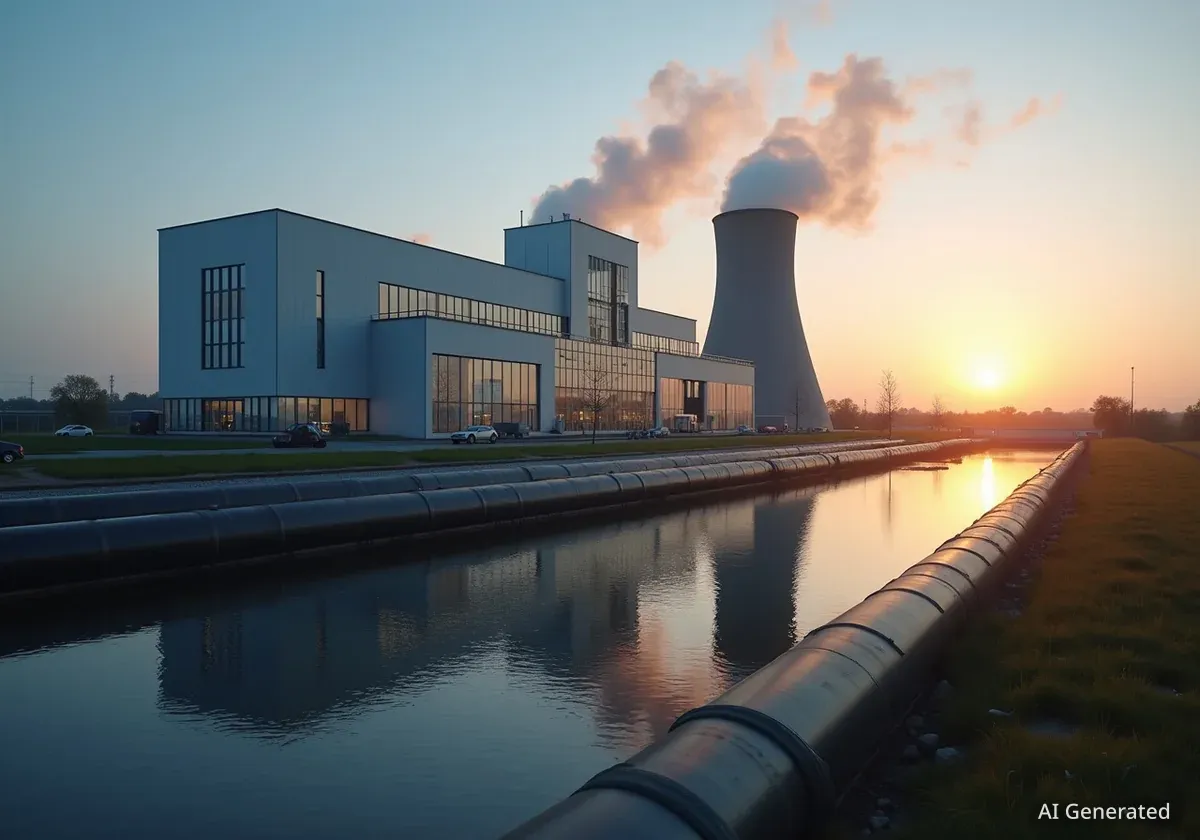The Mersey Heat Energy Centre at Liverpool Waters has officially opened. This new facility will provide low-carbon heating and hot water to the Liverpool Waters development and nearby historic buildings. The opening marks a significant step in the city's plan for low-carbon urban regeneration.
Civic leaders, project partners, and heritage groups attended the opening event. This collaboration highlights Liverpool's commitment to combining its industrial past with a sustainable future.
Key Takeaways
- Mersey Heat Energy Centre uses canal water for low-carbon heating.
- The facility powers Liverpool Waters and major heritage sites.
- It helps Liverpool move towards its net-zero emissions goal.
- The project integrates modern technology with historic infrastructure.
- Liverpool plans further heat network expansion across the city.
New Energy Centre Powers Historic Regeneration
The Mersey Heat Energy Centre is a key part of the Liverpool Waters regeneration project. This project aims to restore historic sites while also building new homes, commercial properties, and modern infrastructure. The energy centre itself uses an innovative system to provide heat.
It draws energy from the Leeds Liverpool Canal's water using advanced heat pumps. This energy then supplies a district heating network. The pumps and extraction equipment are located inside the original Victorian Pump House. This location symbolically connects Liverpool's industrial heritage with its future in low-carbon energy.
Fact: Canal Water Heating
The Mersey Heat Energy Centre uses heat pumps to extract thermal energy from the Leeds Liverpool Canal. This process makes the heating system highly efficient and significantly reduces carbon emissions compared to traditional gas heating.
Collaboration Drives Sustainable Future
Several key partners worked together to bring this project to life. Councillor Liam Robinson, Leader of Liverpool City Council, and Councillor Anthony Burns, Liverpool City Region Combined Authority Cabinet Member for Net Zero, attended the launch. Representatives from Ener-Vate and Vital Energi, the contractor, were also present.
This partnership demonstrates a strong commitment to environmental goals. The project aims to reduce the city's carbon footprint and promote sustainable development across the region.
Councillor Liam Robinson stated, "The launch of the Mersey Heat Energy Centre is a landmark moment in Liverpool’s journey towards a cleaner, greener future. It is a visible example of how Liverpool is leading the way on low carbon infrastructure, protecting historic buildings, cutting emissions and creating long term green value for our communities."
Connecting Landmark Buildings to Green Energy
The network will extend beyond the Liverpool Waters development. Liverpool City Council, the Liverpool City Region Combined Authority, and National Museums Liverpool have signed agreements with Ener-Vate. These agreements will connect prominent buildings to the low-carbon heat supply.
These buildings include the Cunard Building, the George Dock Building, and the Museum of Liverpool. This connection will allow these major cultural and civic landmarks to move away from using gas for heating. The network will also link with a similar scheme at the Albert Dock, creating a wider integrated system.
Heritage and Modernity
The Liverpool Waters regeneration project focuses on both new development and the restoration of historical assets. An example is the Tobacco Warehouse, a Victorian structure from 1901. It was built with approximately 27 million bricks. Historically, goods were moved there using hydraulic jiggers and a rail system. Now, it stands as a symbol of the city's ability to adapt and innovate.
Liverpool's Commitment to Net Zero
Liverpool has an ambitious goal to achieve net-zero emissions. The Mersey Heat Energy Centre is a critical component of this strategy. The city council is also participating in the Department for Energy Security and Net Zero (DESNZ) Advanced Zoning Programme.
Under this program, Liverpool plans to seek a Zone Developer by the end of the financial year. This developer will be responsible for rolling out more heat networks across the city. This proactive approach shows Liverpool's dedication to expanding its green infrastructure.
Councillor Robinson emphasized, "Liverpool has long been a leader in climate action, and this project reinforces our commitment to achieving net zero. It’s not just about infrastructure, it’s about creating a legacy of sustainability that benefits our communities, our economy, and our environment."
Economic and Environmental Benefits
The project offers both environmental and economic advantages. By reducing reliance on fossil fuels, it helps lower carbon emissions. It also creates new job opportunities in the growing green economy. This aligns with the Liverpool City Region's broader goals for sustainable growth and improved quality of life.
According to Councillor Anthony Burns, the centre is a "fantastic example of how we can use our region’s strengths and ingenuity to cut carbon, lower energy bills, and support jobs in the industries of the future." He highlighted the importance of such projects in achieving the region's target to be net zero by 2035, which is at least a decade ahead of the national target.
- Reduced Carbon Emissions: The heat pumps significantly lower the carbon footprint of heating for connected buildings.
- Energy Cost Savings: District heating networks can offer more stable and potentially lower energy costs for consumers.
- Job Creation: The development and operation of such infrastructure create jobs in engineering, construction, and maintenance.
- Preservation of Heritage: Integrating modern technology within historic structures helps preserve architectural heritage while making it functional for the future.
Future Expansion Plans
Ener-Vate, Peel's district heat network specialist, collaborated with Vital Energi on the project. Vital Energi served as the Design, Build, Operate, and Maintain contractor. This partnership ensured the technical and operational readiness of the energy centre.
The success of the Mersey Heat Energy Centre sets a precedent for future developments. Liverpool's participation in the DESNZ Advanced Zoning Programme indicates a clear path for further investment in low-carbon heating solutions. These efforts will continue to position Liverpool as a leader in sustainable urban development.
The city's vision includes a comprehensive network of heat solutions. This will benefit residents, businesses, and public institutions. It aims to create a more resilient and environmentally friendly energy system for the entire Liverpool City Region.





